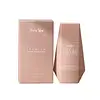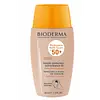What's inside
What's inside
 Key Ingredients
Key Ingredients

 Benefits
Benefits

 Concerns
Concerns

 Ingredients Side-by-side
Ingredients Side-by-side

Water
Skin ConditioningIsododecane
EmollientPolysorbate 20
EmulsifyingButylene Glycol
HumectantSodium Acrylates/Beheneth-25 Methacrylate Crosspolymer
Skin ConditioningMethyl Methacrylate Crosspolymer
Hydrogenated Polydecene
EmollientLauryl Glucoside
CleansingDimethicone
EmollientTrimethylsiloxysilicate
EmollientEthylhexyl Methoxycinnamate
UV AbsorberTitanium Dioxide
Cosmetic ColorantTriethoxycaprylylsilane
PEG-20 Methyl Glucose Sesquistearate
EmulsifyingPolyhydroxystearic Acid
EmulsifyingNeopentyl Glycol Diethylhexanoate
EmollientPhenoxyethanol
PreservativeCI 77492
Cosmetic ColorantTriethanolamine
BufferingOctyldodecanol
EmollientEchium Plantagineum Seed Oil
Skin ConditioningHelianthus Annuus Seed Oil
EmollientCardiospermum Halicacabum Seed Extract
AntimicrobialCardiospermum Halicacabum Flower/Leaf/Vine Extract
Skin ConditioningNelumbo Nucifera Leaf Extract
Skin ConditioningAcrylates/C10-30 Alkyl Acrylate Crosspolymer
Emulsion StabilisingPEG-240
HumectantEthyl Ether
SolventSphingomonas Ferment Extract
Skin ConditioningDisodium EDTA
Water, Isododecane, Polysorbate 20, Butylene Glycol, Sodium Acrylates/Beheneth-25 Methacrylate Crosspolymer, Methyl Methacrylate Crosspolymer, Hydrogenated Polydecene, Lauryl Glucoside, Dimethicone, Trimethylsiloxysilicate, Ethylhexyl Methoxycinnamate, Titanium Dioxide, Triethoxycaprylylsilane, PEG-20 Methyl Glucose Sesquistearate, Polyhydroxystearic Acid, Neopentyl Glycol Diethylhexanoate, Phenoxyethanol, CI 77492, Triethanolamine, Octyldodecanol, Echium Plantagineum Seed Oil, Helianthus Annuus Seed Oil, Cardiospermum Halicacabum Seed Extract, Cardiospermum Halicacabum Flower/Leaf/Vine Extract, Nelumbo Nucifera Leaf Extract, Acrylates/C10-30 Alkyl Acrylate Crosspolymer, PEG-240, Ethyl Ether, Sphingomonas Ferment Extract, Disodium EDTA
Zinc Oxide
Cosmetic ColorantDimethicone
EmollientIsododecane
EmollientIsostearyl Isostearate
EmollientButyrospermum Parkii Butter Extract
Skin ConditioningTitanium Dioxide
Cosmetic ColorantPropylheptyl Caprylate
EmollientDipropylene Glycol
HumectantMethyl Methacrylate Crosspolymer
Silica
AbrasivePolymethylsilsesquioxane
Polyhydroxystearic Acid
EmulsifyingWater
Skin ConditioningHdi/Trimethylol Hexyllactone Crosspolymer
PEG-10 Dimethicone
Skin ConditioningCI 77492
Cosmetic ColorantPolysilicone-11
Triethoxycaprylylsilane
Salicylic Acid
MaskingButylene Glycol
HumectantCapryloyl Glycine
CleansingPropyl Gallate
AntioxidantCI 77491
Cosmetic ColorantHydrogenated Lecithin
EmulsifyingCaprylyl Glycol
EmollientDecyl Glucoside
CleansingTocopherol
AntioxidantEctoin
Skin ConditioningMannitol
HumectantXylitol
HumectantZinc Oxide, Dimethicone, Isododecane, Isostearyl Isostearate, Butyrospermum Parkii Butter Extract, Titanium Dioxide, Propylheptyl Caprylate, Dipropylene Glycol, Methyl Methacrylate Crosspolymer, Silica, Polymethylsilsesquioxane, Polyhydroxystearic Acid, Water, Hdi/Trimethylol Hexyllactone Crosspolymer, PEG-10 Dimethicone, CI 77492, Polysilicone-11, Triethoxycaprylylsilane, Salicylic Acid, Butylene Glycol, Capryloyl Glycine, Propyl Gallate, CI 77491, Hydrogenated Lecithin, Caprylyl Glycol, Decyl Glucoside, Tocopherol, Ectoin, Mannitol, Xylitol
 Reviews
Reviews

Ingredients Explained
These ingredients are found in both products.
Ingredients higher up in an ingredient list are typically present in a larger amount.
Butylene Glycol (or BG) is used within cosmetic products for a few different reasons:
Overall, Butylene Glycol is a safe and well-rounded ingredient that works well with other ingredients.
Though this ingredient works well with most skin types, some people with sensitive skin may experience a reaction such as allergic rashes, closed comedones, or itchiness.
Learn more about Butylene GlycolCi 77492 is also hydrated iron III oxide. It's sole purpose is to give a yellow hue to products.
Iron III oxides are classified as inorganic chemicals for coloring.
Synthetically created Ci 77492 is considered safer than those naturally found. This is because the synthetically created version may contain less impurities. Iron oxides are generally non-toxic and non-allergenic.
Learn more about CI 77492Dimethicone is a type of synthetic silicone created from natural materials such as quartz.
What it does:
Dimethicone comes in different viscosities:
Depending on the viscosity, dimethicone has different properties.
Ingredients lists don't always show which type is used, so we recommend reaching out to the brand if you have questions about the viscosity.
This ingredient is unlikely to cause irritation because it does not get absorbed into skin. However, people with silicone allergies should be careful about using this ingredient.
Note: Dimethicone may contribute to pilling. This is because it is not oil or water soluble, so pilling may occur when layered with products. When mixed with heavy oils in a formula, the outcome is also quite greasy.
Learn more about DimethiconeIsododecane is a fragrance, emollient, and solvent.
As an emollient, it helps your skin stay soft and hydrated. Emollients help trap moisture into your skin.
Isododecane's role as a solvent makes it a great texture enhancer. It spreads smoothly on skin and does not leave a sticky feeling behind. Isododecane also helps prevent color transfer in makeup products.
Isododecane is not absorbed into skin.
Learn more about IsododecaneThis ingredient comes as a powder made up of small, porous, microbeads. It is used to add a silky feel to products and also helps absorb oil.
Polyhydroxystearic Acid is a soft wax made from castor oil.
It is is a texture thickener, emulsifier, and film-former. Emulsifiers prevent ingredients from separating, such as oils and waters.
Polyhydroxystearic Acid may not be fungal acne safe.
Learn more about Polyhydroxystearic AcidTitanium dioxide is a mineral UV filter widely used in sunscreens and cosmetics.
It is one of only two UV filters officially classified as “mineral” by regulatory agencies, the other being zinc oxide.
Titanium dioxide provides broad-spectrum protection mostly in the UVB and UVAII range, with some protection in the UVAI range.
While its UVA protection isn’t as strong as zinc oxide’s, the difference is minor.
A common myth is that mineral UV filters reflect UV light. However, modern research shows titanium dioxide absorbs UV radiation like chemical filters (~95% absorption & 5% reflection).
Thanks to its non-irritating nature, titanium dioxide is suitable for sensitive, acne-prone, or redness-prone skin. It is unlikely to cause "eye sting" like other sunscreen ingredients.
A major drawback of this ingredient is its white cast and thick texture. This is why mineral sunscreens often leave a white cast and are less cosmetically elegant than chemical/hybrid sunscreens.
To improve white cast and spreadability, micronized or nano-sized titanium dioxide is often used.
There are ongoing concerns surrounding nano-titanium oxide's impact on marine ecosystems.
There is no conclusive evidence that any form of titanium oxide (or any other sunscreen ingredients) will cause harm to marine ecosystems or coral reefs. The science is still developing but many consumers are keeping a close eye on this issue.
Please note, many destinations have reef-safety sunscreen rules. For instance, the U.S. Virgin Islands advises all visitors to use non-nano mineral sunscreens.
Nano mineral sunscreens once raised safety concerns about absorption into skin.
Extensive research has shown that they do not penetrate healthy or damaged skin; they remain safely on the surface and the top layer of dead skin (stratum corneum).
You'll likely find titanium dioxide bundled with alumina, silica, or dimethicone. These ingredients help make titanium dioxide highly photostable; this prevents it from interacting with other formula components under UV light.
Learn more about Titanium DioxideTriethoxycaprylylsilane is a silicone used to bind and stabilize ingredients.
As an emulsifier, it helps prevent ingredients from separating. This can help elongate the shelf life of products.
Triethoxycaprylylsilane is often used to coat mineral sunscreens ingredients to help give a better feel. It also helps reduce oxidative stress in sunscreens.
Learn more about TriethoxycaprylylsilaneWater. It's the most common cosmetic ingredient of all. You'll usually see it at the top of ingredient lists, meaning that it makes up the largest part of the product.
So why is it so popular? Water most often acts as a solvent - this means that it helps dissolve other ingredients into the formulation.
You'll also recognize water as that liquid we all need to stay alive. If you see this, drink a glass of water. Stay hydrated!
Learn more about Water